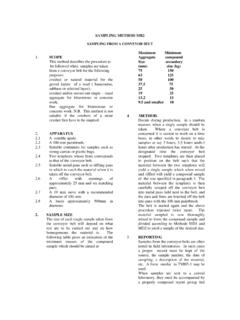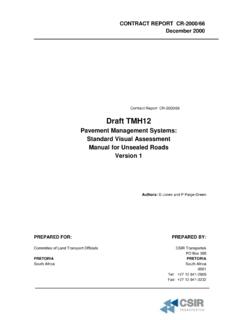Transcription of TECHNICAL METHODS FOR HIGHWAYS SAMPLING …
1 TECHNICAL METHODS FOR HIGHWAYS SAMPLING METHODS FOR ROADS CONSTRUCTION MATERIALS PREFACE TECHNICAL METHODS FOR HIGHWAYS (TMH) is a seriod complementing the TECHNICAL RECOMMENDATIONS FOR HIGHWAYS (TRH) series. The TRHs are intended as guides for the practicing engineer and leave room for engineering judgement to be used. The TMHs are morein the nature of manuals for engineers, prescribing METHODS to be used in various road design and construction procedures. It is hoped that the use of these manuals will produce uniform results throughout the country. The TMH series is also printed and distributed by the National Institute for Transport and Road Research (NITRR) on behalf of the committee for State Road Authorities (CSRA).
2 Any comments or queries on the document should be addressed to: The director, National Institute for Transport and Road Research, CSIR, P O Box 395, Pretoria, 0001. ACKNOWLEDGEMENT This TMH was prepared by the Materials Testing Sub-committee of the highway Materials Committee which is in turn a sub-committee of the Committee for State Road Authorities (CSRA). It carries the full approval of the CSRA. SYNOPSIS TMH5 gives detailed METHODS for taking samples of materials that need to be tested for road construction purposes. METHODS of SAMPLING natural materials, stockpiled material (both treated and untreated) and pavement layers are described.
3 Instructions are also given for sample division using a riffler or by quartering. In the final chapters the background to SAMPLING , the necessity for SAMPLING , evaluation of test results and the reasons behind the METHODS used, are discussed. TMH5 is a companion volume to TMH1 in the TECHNICAL METHODS for HIGHWAYS Page Preface iii Synopsis iv PART I SAMPLING METHODS CHAPTER 1 Foreword 1 CHAPTER 2 Definitions of terms used 2 CHAPTER 3 Specific METHODS for SAMPLING road construction 4 A. NATURAL MATERIALS MA1 SAMPLING of a natural rock mass 5 MA2 SAMPLING from a conveyor belt 7 MA3 SAMPLING by auger 9 MA4 SAMPLING of water for chemical and/or bacteriological tests 10 B. STOCKPILED MATERIAL Untreated materials MB1 SAMPLING of stockpiles 12 MB2 SAMPLING from a conveyor belt 14 MB3 SAMPLING of cement of lime 16 MB4 SAMPLING of bituminous binders 18 MB5 SAMPLING of road marking paint 20 MB6 SAMPLING of steel for concrete reinforcement 21 Treated materials MB7 SAMPLING of premixed asphalt 22 MB8 SAMPLING of slurry mixes 24 MB9 SAMPLING of freshly mixed concrete 25 MB10 SAMPLING of treated pavement layers to determine content and distribution of the stabilizer 27 C.
4 PAVEMENT LAYERS MC1 SAMPLING of road pavement layers 29 MC2 SAMPLING of asphalt and concrete from a completed layer or structure 31 D. GENERAL METHODS MD1 Division of a sample using the riffler 33 MD2 Division of a sample by quartering 35 PART II BACKGROUND TO SAMPLING AS APPLIED TO ROAD CONSTRUCTION MATERIALS 37 CHAPTER 4 Random SAMPLING for road construction quality control 38 CHAPTER 5 Assessment of test results through evaluation and understanding of the sample taken 43 CHAPTER 6 Determination of sample size and sample density 47 CHAPTER 7 Division, making and proposed frequencies of samples 49 LIST OF FORMS TMH5-1 Data form for borrow pits : samples of gravel/soil/rock/sand 6 TMH5-2 Soil survey form 8 LIST OF FIGURES 1 Slotted tube sampler for bulk cement 17 2 Tube sampler for packaged cement 17 3 The riffler 34 4 Quartering on even hard clean surface 35 5 Quartering on canvas sheet 35 PART I SAMPLING METHODS CHAPTER 1 FOREWORD This manual has a twofold purpose.
5 Part I describes the METHODS prescribed for specific applications. The idea is to supplement the METHODS in due course so that eventually all the important material conditions will be covered in this Part. Part II is intended as a manual which: (a) can be used during the theoretical training of students (b) can be used to derive a SAMPLING plan in cases which are not covered by Part I. As discussed in Chapter 5 SAMPLING sizes and METHODS are very often limited by economic considerations. The SAMPLING plans given in Part I do not therefore always comply with the principles stated in Part II as regards the number of samples needed. However, it can be categorically stated that the specified plans are tried and tested and will usually be found to be realistic when the SAMPLING costs are weighed against the value of the information obtained.
6 CHAPTER 2 DEFINITIONS OF TERMS USED Since these definitions form the basis of all discussions in this document, it is suggested that the reader make sure that he thoroughly understands them before he uses the rest of the manual. 1. SAMPLE A sample is a portion or a combination of portions of a lot of a material whose degree of representation is not necessarily important and is therefore not specified. (See Definition 3.) 2. REPRESENTATIVE SAMPLE A representative sample is a portion or a combination of portions of a lot of a material whose degree of representation is important and is therefore specified. (It is important to understand that the representation of a sample varies between the extremes of being poorly representative and absolutely representative.)
7 This simply means that the larger the sample in proportion to the lot, the more representative it becomes, until the whole lot is tested and one may talk in terms of absolute representation.) 3. SAMPLE LOT A lot of material means a discrete specific quantity of the material which can for all practical purposes be regarded as a separate entity and which does not inherently vary disproportionately in respect of the determining characteristics. (See Definition 4.) (The size of a lot is usually determined by: (a) The consignment or delivered quantity. (b) The way in which it is stored when the sample is taken. (c) The variation of the characteristics of the material. A sample lot is therefore the specific heap, load, tank, drum or quantity of material which can be represented by a specific sample.
8 4. DETERMINING CHARACTERISTICS OF A MATERIAL These are characteristics of a material which will determine its performance in the specific use for which it is intended. (The colour of gravel has no direct influence on its performance as a road foundation material. The colour of the gravel is therefore a fortuitous or non-determining characteristic.) 5. MINIMUM ACCEPTABLE SIZE OF A SAMPLE This is the smallest quantity of material which can serve as a sample provided that the determining characteristics of the material can be measured with an acceptable degree of accuracy by means of such a sample. 6. MAXIMUM ACCEPTABLE SIZE OF A SAMPLE The maximum acceptable size of a sample is the largest sample from which the desired degree of representation or accuracy can be obtained relative to the purpose for which the sample was taken.
9 7. PRIMARY OR FIELD SAMPLE This is the sample originally taken from the lot at the storage site, and its size is determined by the degree of representation or accuracy can be obtained relative to the purpose for which the sample was taken. 8. SECONDARY OR LABORATORY SAMPLE This is the sample taken from the original sample which is used to extract the test samples. A secondary sample is divided up to provide the secondary sample is usually obtained by division of the original sample on site and its size is determined by the specific tests for which it is needed. 9. TERTIARY OR TEST SAMPLE This is the material used for a specific test. It is extracted from the secondary sample and its quantity depends on the quantity prescribed for the particular test which is to be done.
10 10. INCREASE OF THE NUMBER OF TESTS When the sample size as prescribed by the test method is too small to ensure a specified degree of accuracy, the number of tests must be increased to give greater confidence about the results obtained. 11. REPRODUCIBILITY OF A TEST This is the degree of variation between the results obtained by the same operator repeating a test on the same material. This factor measures therefore measures the human influence or human error in the execution of a test. 12. REPEATABILITY OF A TEST This is the degree of variation between the results obtained by the same operator repeating a test on the same material. This factor therefore measures the repeatability of the same test under constant conditions, or in other words the precision of the test.








